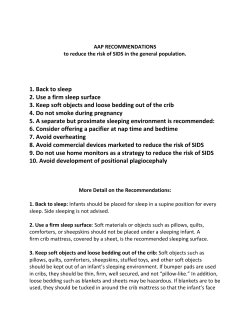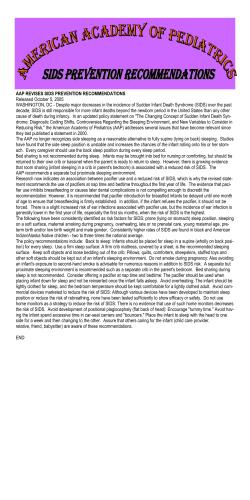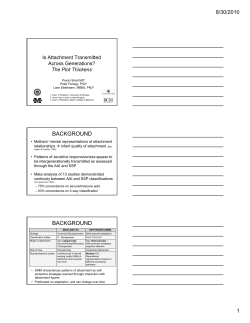
Document 13588
The Promise of Reflective Parenting Approaches What do we know so far and why is this important for policy, research and prac6ce? Anna Huber PhD Candidate Macquarie University Marymead Centre for Early Life MaEers Infant and Early Childhood Social and Emo6onal Wellbeing Conference 2nd Nov 2013 Canberra ì Outline ì Improving social and emo6onal outcomes for children ì ì ì Interven6on with parents The caregiving rela6onship Parental Reflec6ve func6on-‐ is this a key process? ì ì ì What is it? How is it measured? Video examples ì What does early research tell us about PRF? ì Interven6on research-‐ ì ì Approaches which have targeted & measured PRF Research in progress ì Conclusions: Implica6ons for policy, prac6ce and research Improving social and emotional outcomes for children ì Fix child-‐ does not work well with young children-‐ so dependent on caregivers and environment ì Fix parent-‐typical approach to teach parent skills (Parent Educa6on) ì Evidence (eg Wilson et al. 2012 Meta-‐analysis Triple P) ì Mind blind? (Coyne, 2013) ì For whom is this useful/not useful? Parent requires capacity to perceive, respond, flexible repertoire of skills (Cann & McLoughlin 2004) ì Fix environment: typical focus on larger factors e.g. poverty, neighbourhood ì Immediate environment of child is the caregiving rela1onship ì the infant-‐parent rela-onship is emerging as the target of most preven-on and interven-on efforts in infant mental health....That is, rather than assess the infant’s behaviour or the parent’s behaviour as the poten1al foci of change, this approach involves understanding the organisa1on of parent infant behaviours as indices of the rela1onship between the two.” Zeanah (2000) Components of Infant-‐Parent Relationship Developing Attachment System RChild IBChild IBParent Adapted from Stern-‐ Bruschweiler, N. & Stern, D. N. (1989) What you see RParent What you hear Improving social and emotional outcomes for children: Intervening with the caregiving relationship ì AEachment as an index of the past, present and future ì quality of the caregiving rela6onship-‐ what child has experienced/learned to expect with this caregiver ì social and emo6onal wellbeing of the child now ì a predictor of likely developmental outcomes unless things change ì Holy grail of preven6on and interven6on efforts: a4achment ì Ports of entry: where/how in the caregiving rela6onship do we intervene to op6mise SE (aEachment?) outcomes for children? Attachment Theory and Research: key messages ì Securely a4ached children in general have be4er developmental outcomes ì A4achment is rela1vely stable over 1me i.e. Hard to change ì Child’s a4achment is related to ì Caregiver’s behaviour with child (sensi1ve responsiveness) ì Caregiver’s representa1ons (percep1ons): ì What I think and feel about my child & my rela6onship with this child ì What/how I think/feel about my experiences of being cared for by my own parent-‐ Adult a4achment (state of mind) -‐strong predictor; intergenera-onal transmission of a8achment Improving social and emotional outcomes for children: Intervening with the caregiving relationship ì Listen for mother’s representa6on of newborn infant Research suggests key process: Parent’s Reflective Functioning London Parent Child Project 1: ì Parent state of mind (adult aEachment security) on prenatal AAI strongly predicted child aEachment at 1 year ì Reflec1ve comments key > RF Construct ì Reflec1ve Func1oning (RF): Capacity to understand that self/other’s behaviors are linked in meaningful ways to underlying mental states (feelings, wishes, thoughts & desires). ì AAIs re-‐assessed for RF-‐ stronger predictor than AAI as whole Steele H. & Steele, M (2008) : Early evidence for influence of Parents’ Reflective Functioning on child outcomes-‐London Parent Child Project 2: Mothers’ RF scores from their Fathers’ RF scores from their London P arent Child project prenatal AAIs correlated with: prenatal AAIs correlated with: 1. infant-‐mother aEachment at one year 1. infant-‐father aEachment at one year 2. child’s theory of mind & emo6on at five years 2. fathers’ (and mothers’) lower reports of withdrawn, delinquent and aggressive behavior at five years (CBCL) 3. child’s capacity to tell a coherent autobiographical narra6ve at age eleven year 3. lower self-‐reported emo6onal, behavioral and peer problems at age eleven years (acknowledgement to Steele, 2013) Parental Reflective Function (PRF) Slade (2005) ì Reflec6ve func6on in parents should be measured in rela6on to current live rela1onship with child ì Adapted RF Scale for Parent Development Interview (PDI) Defini1on: Demonstrated capacity of a caregiver to reflect on and achieve an understanding of the emo6onal state of his/her own mind and the inner world of his/her child Four general “types” of RF: 1. 2. 3. 4. ì an awareness of the nature of mental states, the explicit effort to tease out mental states underlying behavior, recognizing developmental aspects of mental states, and mental states in rela6on to the interviewer. Well elaborated response will oeen fall into several subtypes (Slade 2006 PDI Manual revision) Measuring Parents’ Reflective Function: Reflections on mental states of self and other in attachment narratives Narra6ve interviews ì Parent Development Interview-‐Rev.(PDI-‐R): Slade et al., 2003); ì ì ì Working Model of the Child Interview (WMCI) (Zeanah et al. 1986, rev. 1993) Circle of Security Interview (COSI) (Cooper et al. 1999) ì ì ì Pregnancy Interview (PI) Contains Qs from PDI & AAI Parent AEachment Interview (PAI) (Bretherton et RF scale ì -‐1 Nega6ve RF ì 1 Lacking RF ì 3 Ques6onable or low RF ì 5 Definite or ordinary RF al.1989) Adult AEachment Interview (AAI) *(George, et al. ì 7 Marked RF 1996) Requirements: “For RF to be reliably scored, the interview must in some way or other demand reflec1on” (Slade 2005) ì 9 Full or Excep6onal RF Definite (average), marked or excep6onal parental reflec6ve func6oning RF=>5 Nega6ve, lacking or low parental reflec6ve func6oning <RF 5 Differences between high and low RF Caregivers Caregivers with Low RF Caregivers with High RF ì Less likely to perceive child's behaviour as problema6c; ì More likely to iden6fy possible reasons underlying behaviour ì ì More able to be both emo6onally involved and in control when child is distressed-‐assists child emo6onal regula6on More likely to have securely aEached child Fonagy, Target, Steele & Steele (1998) RF Manual version 5 for Applica6on to AAI; Slade et al, (2005); Steele et al, (2008) (reflec6ng inability to understand child's inten6onal state): ì Withdraw from child ì Focus on own needs ì Reverse child-‐caregiver role ì Unable to read child's cues/ override them ì Misinterpret child's outer and inner world ì May be antagonis6c towards child Lyons-‐Ruth, Bronfman & Atwood, (1999); Slade et al, (2005b); Kelly et al, (2005) Link between PRF, Caregiving and Child Outcomes: Research so far suggests Parental reflec1ve func1on (PRF) associated with ì Caregiving quality (accuracy of perceiving & adequacy of responding) ì Parents with higher RF-‐ ì more balanced parental representa1ons and ì lower disrupted maternal affec6ve communica6on (i.e. nega6ve caregiving behaviour) (Schechter, 2005; Kelly et al, 2005). ì Child outcomes-‐ higher PRF linked to secure aEachment; lower PRF to insecure (Slade et al, 2005; Steele et al, 2004) ì Be4er caregiving and child outcomes especially in context of adverse histories, depriva1on and risk ì PRF can be a poten1al resilience factor (Fonagy, Steele, Steele, Higgitt & Target, (1994), Schechter et al, (2005) Achieving Child Social and Emotional Wellbeing ì “A parent’s capacity to make sense of her own and her child’s mental states plays a crucial role in helping the child develop ì flexible and adap6ve means of regula6ng himself (Emo6onal) ì establish produc6ve and sustaining rela6onships. (Social) “Presumably, it is the parent’s capacity to tolerate and regulate her own internal, affec6ve experience that allows her to tolerate and regulate these experiences in her child.” (Slade, 2005) ì “In order to help children grow from earliest childhood forward toward their full social and emo-onal poten-al, a central aim of interven-on and preven-on work must be to encourage reflec-ve func-oning in parents or parents-‐to-‐be”. (Steele and Steele 2008) Attachment based interventions ì Past 20 years-‐ prolifera6on of preven6on and early interven6on programs based on aEachment theory and research (Berlin, Zeanah and Lieberman, 2008) ì Earlier rela6onship based interven6ons focused on ì Caregiver sensi6vity (e.g. Van den Boom, 1994) ì Caregiver representa6ons or internal working models (eg Fraiberg, 1980; Heinicke et al., 1999; Lieberman, Silverman, and Pawl, 2000) ì Slade (2005) suggested success of these programs-‐ “actually the result of changes in parental reflec-ve func-oning, a by-‐product of focusing on the parent–child rela6onship.” Components of Infant-‐Parent Relationship PRF: Paying a4en1on to what I and my child may be thinking and feeling and links with my own and my child’s behaviour Developing Attachment System RChild RF on AAI: Measuring parental representa6ons Own Parent (AAI) IBChild IBParent RParent Child (PDI, WMCI) Adapted from Stern-‐ Bruschweiler, N. & Stern, D. N. (1989) What you see What you hear Reflective Parenting Approaches: Common Ingredients (Slade, 2007) Dr. Seuss “A person’s a person, no matter how small.” ì Interven1on aim to develop reflec1ve stance in the parent: thinking about self & child ito internal experience rather than behaviour & personality (physical stance) “I am going to try to understand ..what he is feeling and thinking..& respond to what he is feeling or needing…” ì Behaviour as communica1on ì Link behavior & possible mental states. ì Video to promote standing back, observing self & child, accessing thoughts & feelings ì ì Rela1onship with therapist/ group-‐ holding environment Parent experiences reflec1ve stance in clinician ì Change occurs when parents experience strong emo6ons, then accessible to reflect on together. ì Clinical work aims to help parents tolerate own & child’s mental states ì ì Crucial: help parent consider links between past &present (esp. with high-‐risk parents) Interventions targeting Parental Reflective functioning ì Minding the Baby (Slade Sadler and Close) ì Mother Toddler Program (Suchman et al 2010) ì Toddler Parent Psychotherapy (Toth et al 2008; Vrieze, 2011) ì New Beginnings (Sleed et al, 2013) ì Residen6al Paren6ng Program (Pajulo, 2012) ì Circle of Security (Intensive)(Hoffman et al 2006; Huber, 2013) Interven1on RF Caregiving behaviour Parent represent a1on Infant/Child Other a4achment Change Minding the Baby* Sadler et al, (2013) Ordway et al (2013) High risk young mo.s preg-‐27mths –Home Same-‐I vs C Be4er RF<3 (PI-‐PDI) 2-‐3.6 Be4er (Sadler) Teen mums less disrupted at 4 mths (AMBIANCE) NA Be4er More secure; fewer disorganised at 1 yr Same: Mother’s MH symptoms Be4er: Child bearing gap; infant development; child protec6on referral F/U at 3-‐5yrs: Lower child externalising behaviour Mother Toddler Program* Suchman et al. (2010) Substance abusing mothers & toddlers Be4er (PDI) 3.16-‐3.35 Mod effect Be4er NCAST Be4er (WMCI) Small effect NA Increased regula6on in children between 24 and 36 months of age No diff. in clarity of children’s cues and responsiveness Maternal psychiatric symptoms-‐BDI, BSI-‐ small effect Toddler Parent Psychotherapy* Toth et al (2008) Vrieze (2011) Low risk depressed Be4er-‐ (AAI) Toth 3.44-‐3.97 Same (PAI) Vrieze NA NA Be4er Security not associated with RF Same: Mother’s depression New Beginnings* Sleed et al. (2013) Prison mothers and babies Same 3.18-‐3.54 Controls: worse Same Controls: worse Warmth be4er for both I & C NA Same: Mother’s depression Residen1al paren1ng program Pajulo (2012) Preg-‐4 mths; 1&2yr F/U Be4er (PI-‐PDI) 2.4-‐3.0 Care Index not assoc. with RF; Be4er-‐higher RF less neglect/ maltreatment NA NA Increase in PRF associated with type of substance use & trauma history; Higher RF-‐ less relapse, retained care of child at 1 & 2 yrs Circle of Security Hoffman et al (2006) Huber (2013) Be4er (COSI) 4.01-‐4.63 NA TBA Be4er-‐ Hoffman Huber-‐ Categories-‐Same Scales -‐Be4er Be4er: HOME environment, PEDS Lower: Paren6ng stress (PSI), parental MH symptoms (SCL90R) Child behav.& emot. probs (CBCL, DECA-‐C) Coherence and Caregiving Sensi6vity Do interventions which target Parents’ Reflective Function increase this? ì Yes (MTP, TPP, RPP, COS)-‐ but different effect sizes depending on ì Interven6on used-‐ length, type ì Popula6on-‐ level of risk, age of child, parent educa6on (perhaps) ì Timing/type of RF measurement ì Apparently No (TPP, MTB), but may be due to measurement of RF-‐ ì 6ming, comparison group, interview used ì Only some improve-‐(MTB RF<3; also COS RF<5) ì No-‐ (NB) but may prevent things gewng worse Do interventions targeting PRF result in improved Caregiver Behaviour? ì Yes, on the whole where measured (MTB, PTP, RPP) ì May prevent worse caregiver behaviour (NB) ì Links with RF not clear Do interventions targeting PRF result in improved Caregiver Representations? ì Yes –where measured (MTP) ì No-‐ NB-‐ but self reported warmth beEer for both interven6on & control mothers with babies in prison; changing representa6ons takes 6me ì An area for further inves6ga6on ì Watch this space for COS Do interventions targeting PRF result in improved Attachment? ì Yes – where measured (MTB, TPP, COS) But ì No apparent links with change in parent RF (MTB, TPP, ì Categorical measure of child aEachment may mask posi6ve changes – watch this space re COS ì Ceiling effect-‐ security is a wide range and on its own does not mean everything going well (e.g.pre COS) ì Timing of measurement aeer interven6on may impact (Michigan group) Do interventions targeting PRF result in other improved child or parent outcomes? Child ì Yes – (MTB, MTP, RPP, COS) Child development (MTB, COS) HOME environment (COS) Regula6on in children between 24 & 36 months of age (MTP) ì Child behavioural & emo6onal problems immediately (COS) & at FU 3-‐5 yrs, (MTB) ì SE Protec6ve Factors (COS) ì Neglect/maltreatment if PRF higher (RPP), MTB ì ì ì ì No -‐ (MTP) clarity of children’s cues and responsiveness Parent ì Yes – (MTB, MTP, RPP, COS) ì ì ì ì ì Child bearing gap (MTB) Maternal psychiatric symptoms-‐ (MTP, COS) Higher PRF-‐ less substance abuse relapse (RPP) Paren6ng stress (COS) Higher PRF-‐retained care of child at 1 & 2 yrs (RPP) ì No-‐ (TPP, NB. MTB) ì Maternal depression, MH Symptoms Research in progress ì Circle of Security studies-‐ Australia, Germany (RF on COSI/AAI), Caregiver representa6ons, other SE outcomes for children and parents (MH, Paren6ng stress) ì Minding the Baby studies-‐ US, UK (RF on PI & PDI) ì GABI-‐ Miriam Steele et al. (RF on AAI) ì Other efforts to find alterna6ve ways of measuring PRF-‐ ì Ques6onnaire measure eg PRFQ (Luytens & Mayes) ì Is this the same thing? Implications for Policy ì Limita1ons of parent educa1on ì ì ì Reflec1ve Paren1ng Approaches show promise for improving child social and emo1onal development; ì ì ì ì No change may also show effec6veness in preven6on (e.g. Prison mothers and babies) Look at broad range of indicators of the health/quality caregiving rela6onship May be a differen1al suscep1bility to PRF and interven1ons targe1ng this depending on ì ì Can posi6vely affect rela6onship, parent and child outcomes, both immediately and over 6me Mechanisms s6ll being inves6gated-‐ PRF & changes in caregiving behaviour & representa6ons, child aEachment & other outcomes Look beyond the surface evidence-‐ may not always be clear, or tell story you are looking for ì ì Evidence What works for whom? (Are gaps in Perceiving, Responding, Flexible repertoire?) level of risk, age of child, parent educa6on, interven6on type Best value (e.g. changing developmental trajectories, intergenera1onal transmission) ì ì Look beyond apparent short term effects; Fund research & interven6on together; allow 6me for research to show results. Implications for Practice ì A reflec1ve stance-‐ seeing and guessing about mental states-‐ (thinking, feeling) and links with own & other’s behaviour opens up possibili6es for change ì Working with parents using a rela6onship based reflec6ve approach can foster social and emo6onal growth in infants and young children ì Therapists/prac66oners need to develop/use own reflec6ve capaci6es in order to develop these capaci6es in parents ì Clinical training and ongoing reflec6ve supervision essen6al ì Video assists Implications for Research More investigation needed Studies have not fully addressed ì Which interven1on approaches are effec6ve in increasing PRF and with which popula1ons (e.g., age of child, parental income, educa6on level & mental health, home or clinic based, community/clinical groups) ì Processes through which PRF may improve child outcomes: Theory suggests via more posi6ve caregiving representa6ons and > sensi6ve responsiveness ì Associa1ons between PRF and ì aEachment, parental representa6ons, caregiver behaviour ì child emo6onal/behavioural/other developmental outcomes ì parental stress/mental health ì How best to measure PRF-‐ interviews? other tools? ì If interven6on efforts targe6ng PRF show benefit over 1me? Summary and Conclusion: The promise of Reflective Parenting Approaches ì Interven6ons targe6ng PRF show promise for improving parental caregiving capaci6es and child SE outcomes ì More Interven6on Research needed ì What works for whom? How? ì Links between PRF and outcomes? ì Targe6ng PRF may protect in situa6ons of risk* ì Effec6ve interven6ons require intensity/dura6on/training and reflec6ve supervision End ì Thank you ì [email protected] References Berlin, L. J., Zeanah, C. H. & Lieberman, A. F. (2008) Preven6on and Interven6on Programs for Suppor6ng Early AEachment Security in Cassidy, J & Shaver, P.R. (Eds.) Handbook of A8achment: Theory Research and Clinical Applica-ons. (2nd Edi-on) New York: Guilford Press. Bretherton, I., Biringen, Z., Ridgeway, D., Maslin, M., & Sherman, M. (1989). AEachment: The parental perspec6ve. Infant Mental Health Journal, 10, 203-‐ 220. Centre for Community Child Health, Royal Children's Hospital (2004) Paren-ng Informa-on Project: Literature review, Canberra: Commonwealth of Australia Cooper, Hoffman, Marvin and Powell (1999) Circle of Security Interview in Unpublished Manual: Circle of Security Protocol Coyne, J. (2013) Paren6ng From the Outside-‐in: Reflec6ons on Parent Training During a Poten6al Paradigm Shie. Australian Psychologist Published online doi:10.1111/ap.12010 Fraiberg, S. (1980). Clinical Studies in Infant Mental Health: The First Year of Life. New York: Basic Books, Inc. George, C., Kaplan, N. & Main, M. (1984) Adult A8achment Interview. Unpublished manuscript, University of California, Berkeley. Heinicke, C.M., Fineman, N.R., Ruth, G., Recchia, S.L., Guthrie, D. & Rodning, C. (1999) Rela6onship Based interven6on with at risk mothers: Outcome in the first year of life. Infant Mental Health Journal 20(4) 349-‐374 References Kristen Kelly, ArieEa Slade & John F. Grienenberger Ph.D. (2005): Maternal reflec6ve func6oning, mother–infant affec6ve communica6on, and infant aEachment: Exploring the link between mental states and observed caregiving behavior in the intergenera6onal transmission of aEachment, A8achment & Human Development, 7:3, 299-‐311 doi.org/ 10.1080/14616730500245963 Published online 17 Feb 2007 Lieberman, A.F., Silverman, R. & Pawl, J.H.(2000) Infant-‐parent psychotherapy: Core concepts and current approaches. In Zeanah, C.H. (Ed) Handbook of Infant Mental Health 2nd Ed. 472-‐484 Pajulo, M., Pyykkonen, N., Kalland, M., Sinkkonen, J., Helenius, H., Punamaki, R & Suchman, N. (2012) Substance Abusing Mothers in Residen6al Treatment: Important of Pre-‐ and Postnatal Maternal Reflec6ve Func6oning Infant Mental Health Journal 33(1), 70–81 Sadler, L. (2013-‐09). Minding the Baby: Enhancing Reflec6veness to Improve Early Health and Rela6onship Outcomes in an Interdisciplinary Home-‐Visi6ng Program Minding the Baby. Infant mental health journal, 34(5), 391-‐405.doi:10.1002/imhj.21406 Daniel S. Schechter M.D., Tammy Coots, Charles H. Zeanah, Mark Davies, Susan W. Coates, Kimberly A. Trabka, Randall D. Marshall, Michael R. Liebowitz & Michael M. Myers (2005): Maternal mental representa6ons of the child in an inner-‐city clinical sample: Violence-‐ related posErauma6c stress and reflec6ve func6oning, A8achment & Human Development, 7:3, 313-‐331 Slade et al., (2003) Parent Development Interview Slade, A., Grienenberger, J., Bernbach, E., Levy D. & Locker, A. (2005): Maternal reflec6ve func6oning, aEachment, and the transmission gap: A preliminary study, A8achment & Human Development, 7(3) 283-‐298 References Slade, A. (2007) Reflec6ve Paren6ng Programs Theory and Development Psychoanaly-c Enquiry 26 (4) 640-‐657 Slade (2006) PDI Manual revision Sleed, M. Baradon, T. & Peter Fonagy (2013) New Beginnings for mothers and babies in prison: A cluster randomized controlled trial A8achment & Human Development, Published online April 2013 DOI:10.1080/14616734.2013.782651 Steele H. & Steele, M (2008) On the Origins of Reflec6ve Func6oning. In F.N. Busch (Ed.), Mentaliza-on: Theore-cal considera-ons, research findings, and clinical implica-ons. New York, NY: Taylor & Francis Group. Steele, 2013 Reflec-ve Func-oning Training material presented at Pavia, Italy August 2013 Stern-‐Bruschweiler, N. and Stern, D. N. (1989), A model for conceptualizing the role of the mother's representa6onal world in various mother-‐infant therapies. Infant Mental Health Journal, 10: 142–156. doi: 10.1002/1097-‐0355(198923)10:3<142::AID-‐ IMHJ2280100303>3.0.CO;2-‐M Suchman, N., DeCoste, C., Cas6glioni, N., McMahon, T.J., Rounsaville, B. & Mayes, L.(2010): The Mothers and Toddlers Program, an aEachment-‐based paren6ng interven6on for substance using women: Post-‐treatment results from a randomized clinical pilot, A8achment & Human Development, 12:5, 483-‐504 Suchman, N.E., De Coste, C., Leigh, D. & Borelli. J. (2010): Reflec6ve func6oning in m others with drug use disorders: Implica6ons for dyadic interac6ons with infants and toddlers, A8achment & Human Development, 12:6, 567-‐585 References Van den Boom, D. C. (1994). The influence of temperament and mothering on aEachment and explora6on: An experimental manipula6on of sensi6ve responsiveness among lower-‐class mothers with irritable infants. Child Development, 65, 1457–1477. Wilson, P., Rush, R., Hussey, S., Puckering, C., Sim, F., Allely, C.S., Doku, P., McConnachie, A. & Gillberg, C. (2012), How evidence-‐based is an ‘evidence-‐based paren6ng program’? A PRISMA systema6c review and meta-‐analysis of Triple P BMC Medicine 10:130 hEp:// www.biomedcentral.com/1741-‐7015/10/130 Zeanah, C.H, Benoit, D. & Barton, M. (1986, rev. 1993) Working Model of the Child Interview Accessed at url: hEp:// sundspsykologerna.se/files/C.H-‐Zeanah-‐et-‐al-‐Working-‐Model-‐of-‐the-‐Child-‐Interview.1986-‐1993.pdf Zeanah, C.H. Larrieu, J.A., ScoEe Heller, S., & Valliere, J. (2000) Infant –Parent rela6onship Assessment in In Zeanah, C.H. (Ed) Handbook of Infant Mental Health 2nd Ed. 222-‐235 New York: Guilford Press.
© Copyright 2025


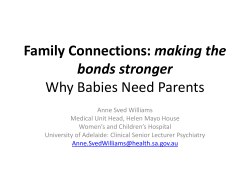
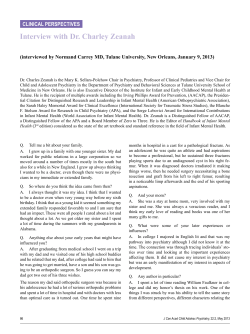
![[ ] On Location](http://cdn1.abcdocz.com/store/data/000057348_2-c69f2e8ee3f1fa593f8b003d2bb33f62-250x500.png)


